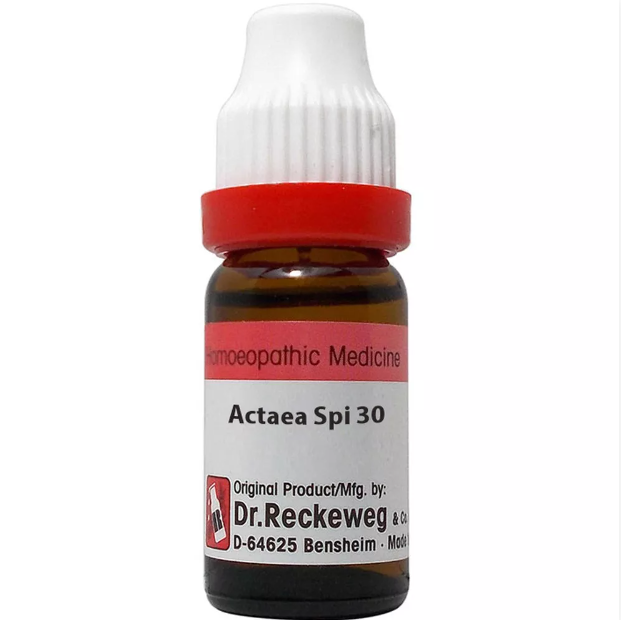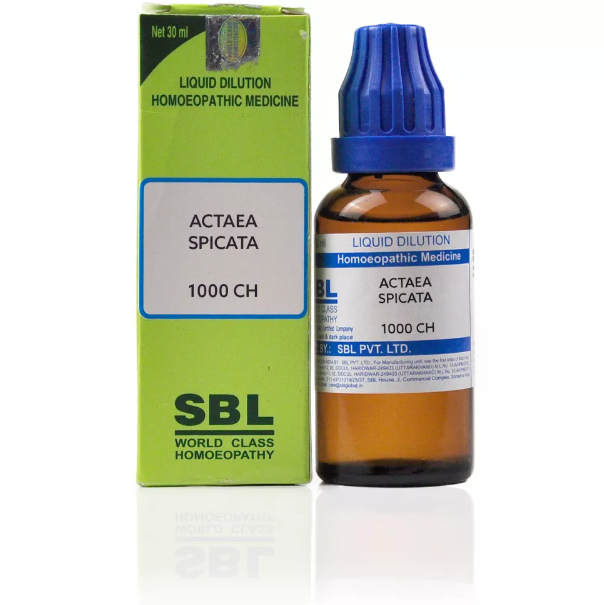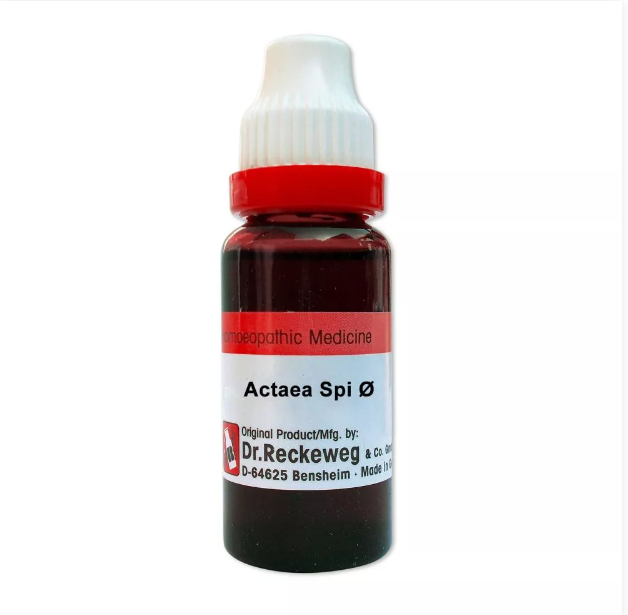ACTAEA SPICATA Q, 6C, 12C, 30C, 200C, 1M, 10M USES AND SYMPTOMS
 Actaea spicata, affectionately known as Baneberry, offers relief for rheumatic discomfort, particularly in delicate joints. Its distinctive traits include sharp, tingling pains, particularly afflicting the wrists. Pulsations ripple through the body, notably in the liver and renal regions, while cardiovascular spasms may occur. Aggravation is evident with touch and movement.
Actaea spicata, affectionately known as Baneberry, offers relief for rheumatic discomfort, particularly in delicate joints. Its distinctive traits include sharp, tingling pains, particularly afflicting the wrists. Pulsations ripple through the body, notably in the liver and renal regions, while cardiovascular spasms may occur. Aggravation is evident with touch and movement.
In the realm of the mind, Actaea spicata induces fear and a tendency to startle easily. A confused state may accompany an upsurge of blood to the head, often triggered by coffee intake. Vertigo, throbbing headaches, and a peculiar pain from crown to brow find solace in the open air. Additionally, facial features experience a violent upper jaw pain and gentle perspiration.
Gastric distress manifests as tearing, darting pains in the epigastric region, potentially leading to vomiting (notably in cases of stomach cancer). Stomach and epigastric cramps, coupled with breathlessness and a sense of suffocation, may ensue. A sudden weariness often follows meals.
The abdomen undergoes spasmodic retraction, and the hypogastrium experiences sticking pain and distention. Respiratory challenges include short, irregular breathing at night and breathlessness in cold air. Extremities suffer tearing loin pain, rheumatic discomfort in small joints, and swollen wrists exacerbated by movement.
SYMPTOMS OF ACTAEA SPICATA
 Rheumatic Remedy:
Rheumatic Remedy:- Affinity for small joints with tearing, tingling pains.
- Notably effective for wrist rheumatism.
General Pains:
- Pulsations throughout the body, especially in the liver (hepatitis) and renal region.
- Cardiovascular spasm.
- Pains worsen with touch and motion.
Head:
- Fearful, easily startled, and confused.
- Ebullition of blood to the head, particularly triggered by drinking coffee.
- Vertigo, tearing headache, throbbing in the brain.
- Heat in the forehead, pain in the left frontal eminence.
- Itching of the scalp alternating with heat.
- Red tip of the nose, fluent coryza.
Face:
- Violent pain in the upper jaw, extending from the teeth through the malar bones to the temples.
- Perspiration on the face and head.
Stomach:
- Tearing, darting pains in the epigastric region, with vomiting (related to stomach cancer).
- Cramp-like pains in the stomach and epigastrium, coupled with difficult breathing and a sense of suffocation.
- Sudden lassitude after eating.
Abdomen:
- Spasmodic retraction.
- Sticking pain and distention of the hypogastrium.
Respiratory:
- Short, irregular breathing at night, especially while lying down.
- Great oppression.
- Shortness of breath upon exposure to cold air.
Extremities:
- Tearing pain in the loins.
- Rheumatic pains in small joints, particularly wrists, fingers, ankles, and toes.
- Swelling of joints with slight fatigue.
- Swollen, red wrists worsened by any motion.
- Paralytic weakness in the hands.
- Lame feeling in the arms.
- Pain in the knee.
- Sudden lassitude after talking or eating.
Relationships:
- Comparison with Caulophyllum, Cimicifuga, Ledum.
selection of the potency
Individualization:
- Homeopathy is based on the principle of treating the individual, not just the disease. The unique symptoms and characteristics of the person are crucial in determining the most suitable potency.
Intensity of Symptoms:
- The intensity of the symptoms guides the choice of potency. If the symptoms are intense and acute, a lower potency (e.g., 6C, 30C) might be considered. For chronic conditions with less intensity, higher potencies (e.g., 200C, 1M) may be appropriate.
Sensitivity of the Patient:
- Some individuals are more sensitive to homeopathic remedies, while others may require higher potencies. The practitioner considers the patient’s sensitivity when selecting the potency.
Acute vs. Chronic Conditions:
- Lower potencies are often used for acute conditions, while higher potencies may be considered for chronic or long-standing issues.
Previous Response to Potencies:
- The patient’s response to previous homeopathic treatments helps guide the choice of potency. If a particular potency has been effective in the past, it may be repeated or adjusted as needed.
Vital Force and Susceptibility:
- Homeopathy views illness as a disturbance in the vital force. The practitioner assesses the patient’s overall vitality and susceptibility to determine the appropriate potency.
Aggravation or Amelioration:
- The direction of the symptom response (aggravation or amelioration) after taking a remedy can influence the choice of potency.
Miasmatic Considerations:
- In classical homeopathy, the concept of miasms (inherited disease tendencies) is considered. The practitioner take this into account when selecting the potency.
Practitioner Experience:
- The experience and preference of the homeopathic practitioner play a role. Some practitioners may have success with certain potencies based on their clinical experience.
SAFETY INFORMATION
- Do not exceed the recommended dose by physician
- Keep out of the reach of children
- Store in a cool dry place away from direct sunlight
- Maintain half an hour gap between food/drink/any other medicines and homoeopathic medicine
- Avoid any strong smell in the mouth while taking medicine e.g. camphor, garlic, onion, coffee, hing
Medicine images use for reference only selection of homeopathic medicine depends on the individual’s specific symptoms and overall constitution. Moreover, homeopathy is a holistic system of medicine that treats the individual as a whole. In addition to addressing the physical symptoms, it takes into account the emotional and mental state of the person. Consequently, it’s crucial to consult with a qualified homeopathic practitioner for personalized treatment.
The information provided on this website is intended solely for educational purposes. Always seek the advice of your physician or other qualified health provider.
